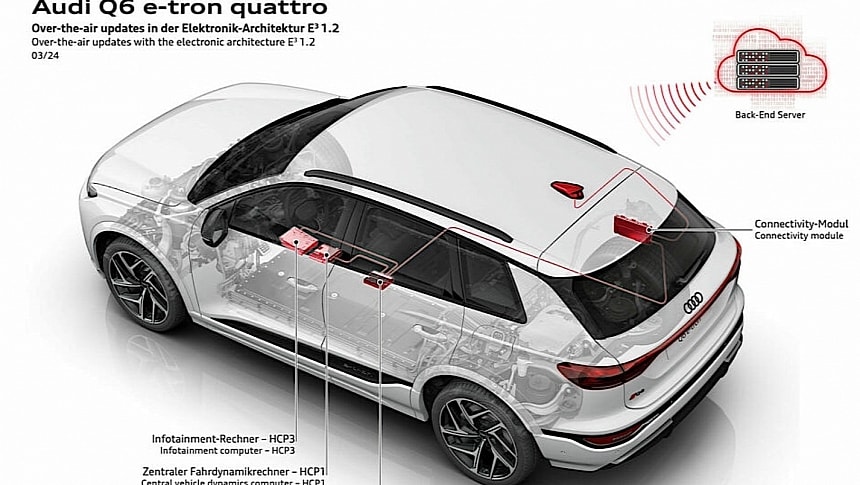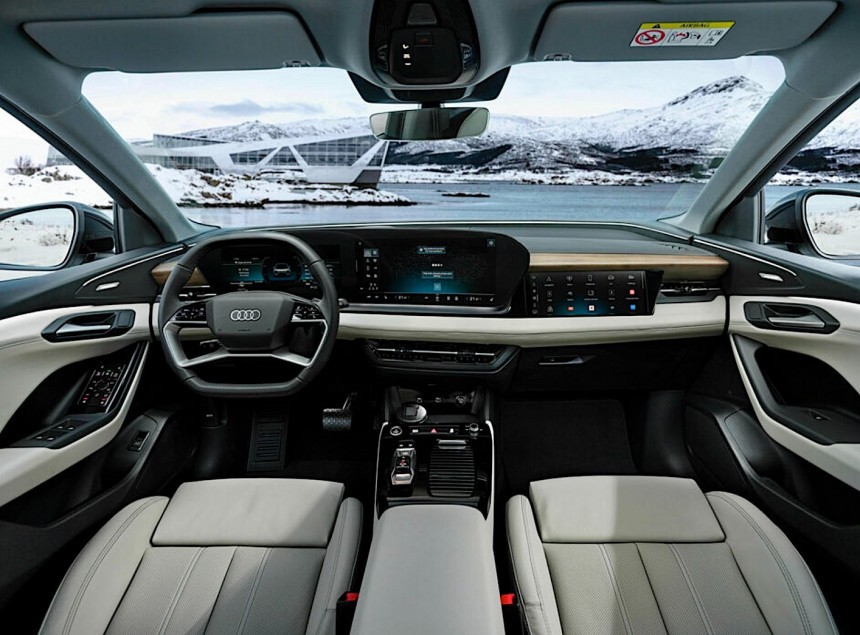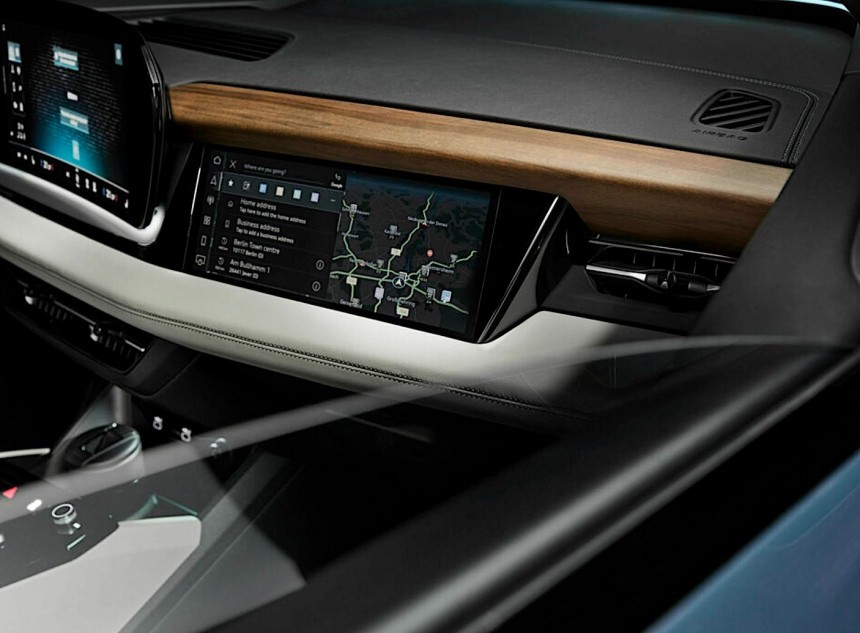This week marked the launch of the new Audi Q6 e-tron into the world. Undoubtedly one of the most important premieres of the automotive world this year so far, the SUV that is meant to kickstart a "new generation of electrically powered vehicles at Audi" is much more than it meets the eye, as changes run very deep with this one.
The electric Q6 is virtually new all over, being built on a new platform, equipped with new charging and battery tech, and running what Audi describes as being a brand-new electronics architecture to underpin it all.
It's this latter electronics architecture component of the vehicle we'll be focusing on in this story, but not before reminding you a bit about what the spectacular European EV is made of elsewhere.
The Q6 e-tron is the company's first production model to be built on the so-called Premium Platform Electric (PPE). The result of work conducted by Audi together with Porsche, the platform is purpose-built to accommodate components for battery electric vehicles.
In the case of the Q6 that means a rather massive 100 kWh battery pack comprising twelve modules and 180 prismatic cells. The system is capable of holding enough electricity to spin the wheels for as much as 625 km (388 miles).
The electric motors that draw power from the battery have a combined power output of 382 horsepower - for the more potent SQ6 e-tron power levels take a serious jump to 510 horsepower.
The above numbers are enough to accelerate the SUV from a standstill to 62 mph in 5.9 seconds (4.3 seconds for the SQ6), and to top speeds that reach 210 kph (130 mph) and 230 kph (142 mph), respectively.
But those are details you probably already know by now, and we did promise we'll focus this time on the electronics architecture of the new Q6 family. The collection of hardware is called in Audi speak E3 1.2, and it is meant to revolutionize how the cars of the four-rings brand behave, interact with their drivers, and evolve.
Building on the hardware it already uses on production cars and SUVs, Audi envisioned, together with dedicated Volkswagen software specialist Cariad, the 1.2 version of the E3 system. That's a name that stands for end-to-end electronic architecture and is meant to be scalable and future-proof, meaning it will allow upgrades without requiring a major redesign.
At the heart of the tech sit no less than five computers the Germans like to refer to as high-performance computing platforms, or HCP. They are meant to govern all of the functions of the Q6, from the ones that take care of the comfort of the passengers to the driver's assistance of the vehicle.
The first computer, the HCP1, for instance, is tasked with handling the drive system and suspension, including longitudinal and lateral dynamics. HCP2 takes care of the driver assistance systems, while the infotainment functions fall under HCP3.
The fourth computer governs comfort functions (trivial yet crucial stuff like light control, air conditioning and seat adjustment). Last in the bunch, but certainly not least, is the HCP5, which takes care of the communication between all the other computers but also ensures connectivity with the outside world.
To do that, the computer relies on standard broadband connections but has also been built to operate on the Gigabit Ethernet standard.
I said earlier that the E3 1.2 system will shape Audi's future, and that's exactly what the company plans for the tech. Deployed for the first time in the Q6, it will make its way into all future Audi models, becoming the new standard. It's likely cars made by the other brands operating under the Volkswagen Group umbrella will follow suit and use it as well.
More than that, the E3 is upgradable by means of over-the-air updates on software and functionality levels. The cherry on the cake is that the technology opens the doors for a larger number of screens to be used in future vehicles, and also allows for the dimensions of these screens to be greater than they are now.
To be able to accommodate the E3 1.2, the new Audi Q6 e-tron family has been imagined with a fully networked digital interior. And that, together with all the other enhancements made to it over what came before does not make it cheap.
The SUV will be available for European customers to purchase by the end of the month. In its normal guise it will sell for 74,700 euros, while the more capable SQ6 variant will retail from 93,800 euros.
The American market will get them too, but the carmaker did not disclose details on exactly when and for how much. To give a sort of reference point, though, consider the fact that at current exchange rates the above prices would translate for the American market into $81,000 for the Q6 and almost $102,000 for the SQ6.
It's this latter electronics architecture component of the vehicle we'll be focusing on in this story, but not before reminding you a bit about what the spectacular European EV is made of elsewhere.
The Q6 e-tron is the company's first production model to be built on the so-called Premium Platform Electric (PPE). The result of work conducted by Audi together with Porsche, the platform is purpose-built to accommodate components for battery electric vehicles.
In the case of the Q6 that means a rather massive 100 kWh battery pack comprising twelve modules and 180 prismatic cells. The system is capable of holding enough electricity to spin the wheels for as much as 625 km (388 miles).
The electric motors that draw power from the battery have a combined power output of 382 horsepower - for the more potent SQ6 e-tron power levels take a serious jump to 510 horsepower.
The above numbers are enough to accelerate the SUV from a standstill to 62 mph in 5.9 seconds (4.3 seconds for the SQ6), and to top speeds that reach 210 kph (130 mph) and 230 kph (142 mph), respectively.
Building on the hardware it already uses on production cars and SUVs, Audi envisioned, together with dedicated Volkswagen software specialist Cariad, the 1.2 version of the E3 system. That's a name that stands for end-to-end electronic architecture and is meant to be scalable and future-proof, meaning it will allow upgrades without requiring a major redesign.
At the heart of the tech sit no less than five computers the Germans like to refer to as high-performance computing platforms, or HCP. They are meant to govern all of the functions of the Q6, from the ones that take care of the comfort of the passengers to the driver's assistance of the vehicle.
The first computer, the HCP1, for instance, is tasked with handling the drive system and suspension, including longitudinal and lateral dynamics. HCP2 takes care of the driver assistance systems, while the infotainment functions fall under HCP3.
The fourth computer governs comfort functions (trivial yet crucial stuff like light control, air conditioning and seat adjustment). Last in the bunch, but certainly not least, is the HCP5, which takes care of the communication between all the other computers but also ensures connectivity with the outside world.
To do that, the computer relies on standard broadband connections but has also been built to operate on the Gigabit Ethernet standard.
More than that, the E3 is upgradable by means of over-the-air updates on software and functionality levels. The cherry on the cake is that the technology opens the doors for a larger number of screens to be used in future vehicles, and also allows for the dimensions of these screens to be greater than they are now.
To be able to accommodate the E3 1.2, the new Audi Q6 e-tron family has been imagined with a fully networked digital interior. And that, together with all the other enhancements made to it over what came before does not make it cheap.
The SUV will be available for European customers to purchase by the end of the month. In its normal guise it will sell for 74,700 euros, while the more capable SQ6 variant will retail from 93,800 euros.
The American market will get them too, but the carmaker did not disclose details on exactly when and for how much. To give a sort of reference point, though, consider the fact that at current exchange rates the above prices would translate for the American market into $81,000 for the Q6 and almost $102,000 for the SQ6.



























